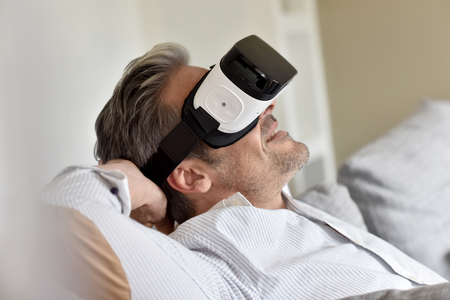Virtual Reality Emerging as Possible Alternative to Opioids for Pain
Tuesday, March 27, 2018 | 0
Whether virtual reality therapy can help reduce pain following an orthopedic injury and help patients return to work more quickly are questions that will be explored through a clinical trial that is underway at Cedars-Sinai Medical Center.
 And the nation’s largest workers’ comp insurer, the Travelers Cos., announced this month that it is collaborating with Cedars-Sinai on the project, along with partners Samsung Electronics America, Bayer and AppliedVR.
And the nation’s largest workers’ comp insurer, the Travelers Cos., announced this month that it is collaborating with Cedars-Sinai on the project, along with partners Samsung Electronics America, Bayer and AppliedVR.
Although the study isn’t specific to work comp claimants, Travelers said it could have implications for the industry.
“Identifying new, non-pharmacologic alternatives for pain management can help an injured employee avoid chronic pain, lower the chances that they will develop a dangerous opioid addiction, and reduce medical costs,” said Melissa Burke, Travelers’ national pharmacy director.
Participants in the study will be patients seeking care for an orthopedic injury that occurred within the past six weeks, such as an arm or leg injury, or lower-back pain. They will be experiencing pain that they rate as a 3 or higher on a 10-point scale.
Participants will receive a “digital pain-reduction kit” that includes a virtual reality system with content intended to relieve pain and anxiety. They will also receive a transcutaneous electrical nerve stimulation, or TENS unit, which can be used separately to treat low-back pain.
Another part of the kit is a Samsung Fit2 smart watch that monitors activity and heart rate. A control group of study participants will receive only the watch.
Participants will complete a weekly survey detailing their physical function, to what extent pain is interfering with their activities and how much they’re able to work. The investigators will also examine opioid prescribing to participants over the course of the study. The 16-month study will include 90 to 140 participants.
“We need to find ways to stem the tide (of the opioid crisis) without relying entirely on medicines,” said Dr. Brennan Spiegel, director of the Center for Outcomes Research and Education at Cedars-Sinai. “Health technology like virtual reality has tremendous potential to improve outcomes while saving costs.”
The new clinical trial is a follow-up to the Cedars-Sinai group’s study of virtual reality for treating pain in hospital patients. During the study, 50 hospital patients with pain scores of 3 or more on a 10-point scale used virtual reality goggles to watch videos that are intended to calm.
Another 50 patients viewed a standard, two-dimensional nature video with a soothing soundtrack. Those patients felt a 13.2% reduction in pain, less dramatic than the decrease in the VR group. The results were published in March 2017.
Eldin Dzubur, project scientist in the Center for Outcomes Research and Education at Cedars-Sinai, said the new study will expand on the previous results by testing virtual reality as an outpatient therapy for pain.
Another change is that patients will now have access to a “mindfulness” module in the virtual reality system, in which they will learn to focus on their breathing. Once the mindfulness techniques are learned, they can be used to help manage pain even when the patient is not using the virtual reality equipment — for example, when they’re at work.
The amount of virtual reality content has also been expanded, Dzubur said. In addition to virtually experiencing helicopter rides over Iceland or swimming in the ocean with whales, participants will be able to tour California’s redwood forests, relax on a beach or shoot cartoon bears with rubber balls.
Virtual reality is intended to distract patients from their pain.
“Immersive VR is extremely effective at absorbing attention away from perceiving pain, thinking about pain and experiencing anxiety that can exacerbate pain,” according to AppliedVR, one of the collaborators in the study.
Among those who will be watching the results of the new study are Dr. Steve Moskowitz, senior medical director at Paradigm Outcomes. The company manages medical treatment for catastrophic injuries.
“This exploration of non-medication alternatives, chronic-pain prevention and injured worker self-management is exciting,” Moskowitz said. “I hope the study design allows us to determine how effective virtual reality systems are in the population studied and what combination of interventions makes the true difference.”
Zack Craft, vice president and national product leader at One Call Care Management, has also been keeping an eye on virtual reality as a possible therapy for injured workers. He said one advantage for the technology is that the hardware is well developed, giving software developers something solid to work with.
But Craft said many questions remain. For example, how will clinicians code for the therapy on billing, and how much will be charged? In cases of chronic pain, payers could be making a long-term commitment to the therapy, Craft said, raising questions of how often the equipment needs to be replaced and whether patients will use it consistently.
Another issue is whether a patient receiving the device for treatment of pain will instead use it for recreational gaming, Craft said.
“We still have a long way to go,” Craft said.



Comments